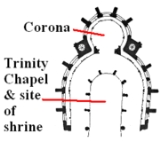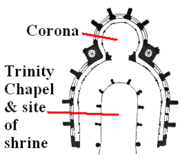
Trinity Chapel
Encyclopedia
Trinity Chapel in Canterbury Cathedral
forms part of a UNESCO World Heritage Site. The chapel was added by William the Englishman as a shrine for the relics of St. Thomas Becket
. The shrine became one of the most popular pilgrimage
sites in England.
 In 1220, Becket's remains were relocated from his first tomb to the finished chapel. As a result of this event, the chapel became a major pilgrimage site, inspiring Geoffrey Chaucer
In 1220, Becket's remains were relocated from his first tomb to the finished chapel. As a result of this event, the chapel became a major pilgrimage site, inspiring Geoffrey Chaucer
to write The Canterbury Tales
in 1387 and with routes (eg from Southwark (Chaucer's route) and the Pilgrim's Way to/from Winchester) converging on the cathedral. Becket's shrine stood until it was destroyed in 1540. This was done on orders from King Henry VIII
as vengeance for his ancestor, Henry II
. The king also destroyed Becket's bones and ordered that all mention of his name be obliterated. The pavement where the shrine stood in the chapel is today marked by a lighted candle. Modern day archbishops of Canterbury celebrate the Eucharist
at this place to commemorate Becket's martyrdom and the translation of his body from his first burial place to this chapel.
). He was buried on the south side of the shrine of Thomas Becket behind the quire. His tomb consists of a bronze effigy beneath a tester
depicting the Holy Trinity, with his heraldic achievements hung over the tester. The achievements have now been replaced by replicas, though the originals can still be seen nearby, and the tester was restored in 2006.
. Unusual for a King of England, he was buried not at Westminster Abbey
but at Canterbury Cathedral, on the north side of Trinity Chapel as near to the shrine of Thomas Becket
as possible. Becket's cult was then at its height, as evidenced in the Canterbury Tales, and Henry was particularly devoted to it (he was anointed at his coronation with oil supposedly given to Becket by the Virgin Mary, which had then passed to Henry's father). Henry was given an alabaster effigy, alabaster being a valuable English export in the 15th century. His body was well embalmed, as a Victorian
exhumation some centuries later established
was built at the eastern end of the chapel to contain the relic of the crown of St. Thomas's head which was struck off during his murder.
Canterbury Cathedral
Canterbury Cathedral in Canterbury, Kent, is one of the oldest and most famous Christian structures in England and forms part of a World Heritage Site....
forms part of a UNESCO World Heritage Site. The chapel was added by William the Englishman as a shrine for the relics of St. Thomas Becket
Thomas Becket
Thomas Becket was Archbishop of Canterbury from 1162 until his murder in 1170. He is venerated as a saint and martyr by both the Roman Catholic Church and the Anglican Communion...
. The shrine became one of the most popular pilgrimage
Pilgrimage
A pilgrimage is a journey or search of great moral or spiritual significance. Typically, it is a journey to a shrine or other location of importance to a person's beliefs and faith...
sites in England.
Thomas Becket

Geoffrey Chaucer
Geoffrey Chaucer , known as the Father of English literature, is widely considered the greatest English poet of the Middle Ages and was the first poet to have been buried in Poet's Corner of Westminster Abbey...
to write The Canterbury Tales
The Canterbury Tales
The Canterbury Tales is a collection of stories written in Middle English by Geoffrey Chaucer at the end of the 14th century. The tales are told as part of a story-telling contest by a group of pilgrims as they travel together on a journey from Southwark to the shrine of Saint Thomas Becket at...
in 1387 and with routes (eg from Southwark (Chaucer's route) and the Pilgrim's Way to/from Winchester) converging on the cathedral. Becket's shrine stood until it was destroyed in 1540. This was done on orders from King Henry VIII
Henry VIII of England
Henry VIII was King of England from 21 April 1509 until his death. He was Lord, and later King, of Ireland, as well as continuing the nominal claim by the English monarchs to the Kingdom of France...
as vengeance for his ancestor, Henry II
Henry II of England
Henry II ruled as King of England , Count of Anjou, Count of Maine, Duke of Normandy, Duke of Aquitaine, Duke of Gascony, Count of Nantes, Lord of Ireland and, at various times, controlled parts of Wales, Scotland and western France. Henry, the great-grandson of William the Conqueror, was the...
. The king also destroyed Becket's bones and ordered that all mention of his name be obliterated. The pavement where the shrine stood in the chapel is today marked by a lighted candle. Modern day archbishops of Canterbury celebrate the Eucharist
Eucharist
The Eucharist , also called Holy Communion, the Sacrament of the Altar, the Blessed Sacrament, the Lord's Supper, and other names, is a Christian sacrament or ordinance...
at this place to commemorate Becket's martyrdom and the translation of his body from his first burial place to this chapel.
The Black Prince
Over time other significant burials took place in this area such as Edward Plantagenet (the Black PrinceEdward, the Black Prince
Edward of Woodstock, Prince of Wales, Duke of Cornwall, Prince of Aquitaine, KG was the eldest son of King Edward III of England and his wife Philippa of Hainault as well as father to King Richard II of England....
). He was buried on the south side of the shrine of Thomas Becket behind the quire. His tomb consists of a bronze effigy beneath a tester
Canopy (building)
A canopy is an overhead roof or else a structure over which a fabric or metal covering is attached, able to provide shade or shelter. A canopy can also be a tent, generally without a floor....
depicting the Holy Trinity, with his heraldic achievements hung over the tester. The achievements have now been replaced by replicas, though the originals can still be seen nearby, and the tester was restored in 2006.
King Henry IV
Also buried there is King Henry IVHenry IV of England
Henry IV was King of England and Lord of Ireland . He was the ninth King of England of the House of Plantagenet and also asserted his grandfather's claim to the title King of France. He was born at Bolingbroke Castle in Lincolnshire, hence his other name, Henry Bolingbroke...
. Unusual for a King of England, he was buried not at Westminster Abbey
Westminster Abbey
The Collegiate Church of St Peter at Westminster, popularly known as Westminster Abbey, is a large, mainly Gothic church, in the City of Westminster, London, United Kingdom, located just to the west of the Palace of Westminster. It is the traditional place of coronation and burial site for English,...
but at Canterbury Cathedral, on the north side of Trinity Chapel as near to the shrine of Thomas Becket
Thomas Becket
Thomas Becket was Archbishop of Canterbury from 1162 until his murder in 1170. He is venerated as a saint and martyr by both the Roman Catholic Church and the Anglican Communion...
as possible. Becket's cult was then at its height, as evidenced in the Canterbury Tales, and Henry was particularly devoted to it (he was anointed at his coronation with oil supposedly given to Becket by the Virgin Mary, which had then passed to Henry's father). Henry was given an alabaster effigy, alabaster being a valuable English export in the 15th century. His body was well embalmed, as a Victorian
Victorian era
The Victorian era of British history was the period of Queen Victoria's reign from 20 June 1837 until her death on 22 January 1901. It was a long period of peace, prosperity, refined sensibilities and national self-confidence...
exhumation some centuries later established
The Crona Tower
The Corona TowerThe Corona, Canterbury Cathedral
The Corona is the east end of Canterbury Cathedral, named after the severed crown of Thomas Becket , whose shrine it was built to contain....
was built at the eastern end of the chapel to contain the relic of the crown of St. Thomas's head which was struck off during his murder.

